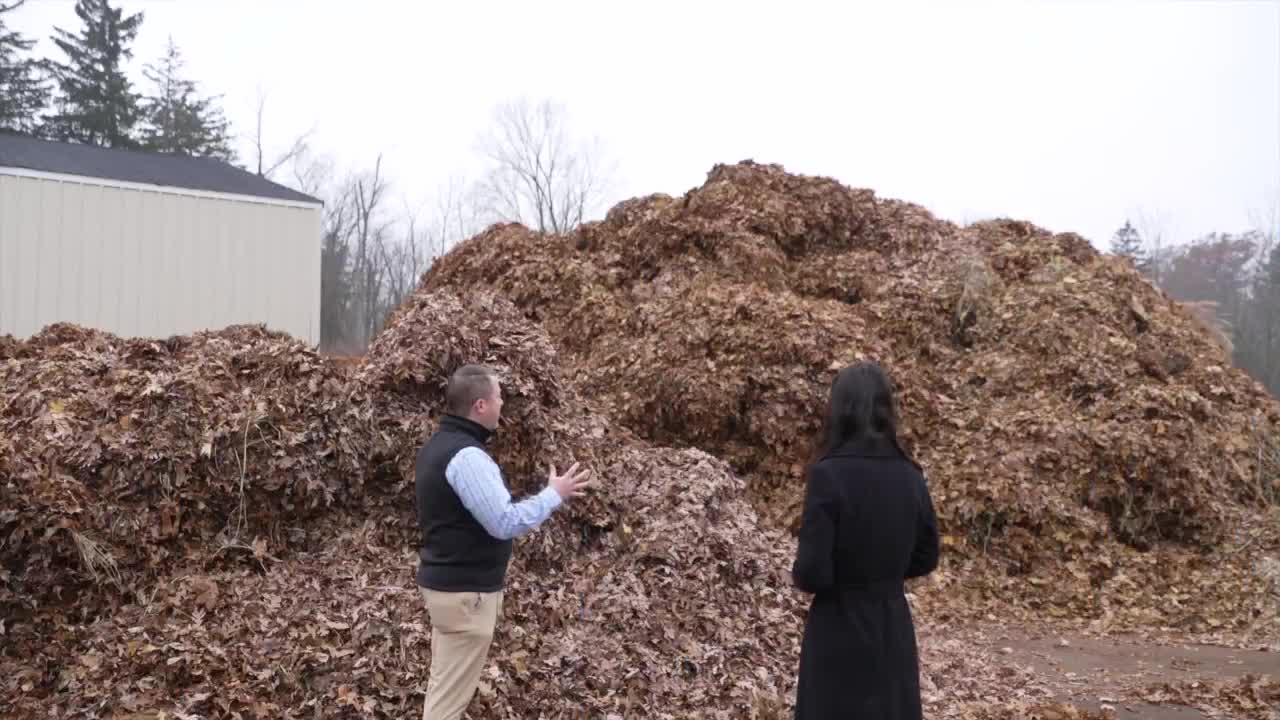EAST GRAND RAPIDS, Mich. — As fall turns to winter, East Grand Rapids is completing its final rounds of leaf collection for the year, serving approximately 4,000 households throughout the city.
The city's Department of Public Works collects massive amounts of organic material each season, creating towering piles at their facility.
"What you see here, this is just from a few days this week only," said Doug La Fave, Deputy City Manager and Director of Public Works, standing in front of a mountain of collected leaves at the Department of Public Works.
The city processes significant volumes of yard waste annually through its free collection service that has operated for decades.
"We do about 16,000 yards of material a year. That's the equivalent of about 1150 trips with one of our yard waste packer trucks," La Fave said.
Specialized collection process
East Grand Rapids uses a unique approach to leaf collection that sets it apart from other municipalities. Beginning the second full week of October, the city asks residents to place their leaves in a pile, on the edge of the street for pick up.
"We ask residents to go ahead and put out their leaves and other yard waste in loose form, which means just out at an edge of the street, not blocking bike lanes, not blocking travel lanes," La Fave said.
The city uses specialized equipment with claw attachments that follow curb lines to load material into packer trucks. Homeowners don't pay additional fees for the service, which runs weekly from April through December.
"What we're trying to do is we're trying to make it as easy as possible for residents to participate," La Fave said. "What we see is a greater participation in this process, because there's no pay for service. There's no limits to the amount that you can put out. And it's something that is easier for people to do."
Environmental benefits of proper disposal
The collected material follows a sustainable disposal process that provides environmental advantages over other disposal methods.
"They get picked up here and brought to our public works complex as kind of a transfer station, then the city has those transported to a composting facility where they're composted," La Fave said.
The yard waste travels to a composting facility in Rockford, where it undergoes a controlled decomposition process. Workers place material in rows, grind and turn the piles while monitoring temperatures until the organic matter transforms into usable soil.
"It turns into a soil material, and then they store that and sell that to other commercial, residential customers, including the city of East Grand Rapids," La Fave said.
Nathan Williams, an environmental project engineer for the city of Grand Rapids, explained why composting provides environmental benefits beyond simple disposal.
"If you can keep leaves, keep organic material generally in the same area, it's going to have benefits in terms of how it impacts your insect population, your micro population, and you're returning the same type of microbiome back to that same area," Williams said.
Preventing water quality issues
Proper leaf disposal helps protect local waterways from environmental damage. When leaves enter storm drains and waterways, they can create oxygen depletion problems.
Williams explained that biodegrading organic material "absorbs oxygen as the microbes work, as that degradation process happens. And so it sucks oxygen out of the water, which is bad for all the things in that natural environment that rely on oxygen."
This process can negatively impact fish, invertebrates and plants throughout water systems, including Reeds Lake and downstream waterways.
Flooding prevention
Beyond water quality concerns, leaves in streets create immediate flooding risks during fall rain events.
"We do see quite commonly in this season, with fall leaves yard debris, a lot of our basins can get clogged pretty easily once all that stuff washes down the road and kind of cakes onto a basin," Williams said.
The environmental engineer noted that residents can help by keeping catch basins clear and removing leaves from roadways.
Complete recycling circle
East Grand Rapids purchases back composted soil made from collected leaves, creating a full recycling loop for the community.
"Composting process back to the residents that gave us the leaves, back to their yards or other construction projects right here in the city," La Fave said.
The city uses the composted material for water service repairs and restoration projects, often returning processed soil to the same residents who originally contributed the leaves.
Alternatives for homeowners
Williams suggested residents can benefit from managing some organic waste on their own property.
"If you can keep as many leaves on your property as possible, by mulching them up, by collecting them and dispersing them around flower beds, tree bases, that sort of thing, you're able to keep all those nutrients on your own property," Williams said.
He noted that leaf litter provides habitat for beneficial insects, including fireflies that lay eggs in organic debris.
Program longevity
East Grand Rapids has utilized this composting process for decades, with La Fave noting the system has been in place "for at least 40 years, 40 plus years in its form."
The city covers approximately 100 linear miles of roads weekly, providing service to all households in the community through specialized trucks and equipment adapted specifically for the collection process.
East Grand Rapids will complete its fall leaf collection on Dec. 5.
For more information on rules and routes, click here.
WATCH THE VIDEO STORY
This story was initially reported by a journalist and has been converted to this platform with the assistance of AI. Our editorial team verifies all reporting on all platforms for fairness and accuracy.





